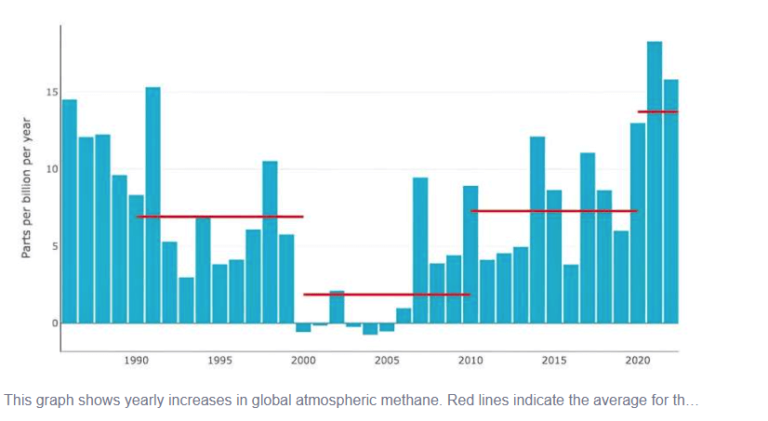Accelerating Danger – Part 2: Unmasking the Drivers of Accelerated Heating
Introduction
The evidence is mounting that global heating is picking up speed. But what’s driving this heating upswing? Natural events like El Niño can supercharge heat temporarily, yet the persistence and extent of the record-breaking warmth suggests something more fundamental is happening. And that brings us to a controversial idea in climate science today: the real impact of “aerosol masking”. Whether the true impact of our emissions have been hidden by aerosols, at least to this point in time, and if so, what are the consequences? These are questions explored in this Part 2 of Accelerating Danger.
What is causing this unexpected acceleration in global heating?
Untangling the drivers of the global heating surge experienced in 2023 and 2024 is not easy and is controversial as it yet again draws in ideological driven opposition to any narrative that points towards human rather than natural causes.
The primary candidate for natural causes might appear to be the passing of the natural El Nino climate event in 2023 and 2024 which, as David Pratt explains in this Climate Code Red article, caused a spike in temperatures in 1997-98 and again in 2015-16, followed by subsequent global cooling in following years of more than 0.3C and 0.2C respectively. So on this basis, 2025 is the crunch year to test this theory that the last two years are on- trend heating and not an aberration once the El Nino spike is levelled off.
But unfortunately for this is account, as Carbon Brief reports, 2025 is already on track to be the second or third warmest on record, so not the substantial cooling that a post El Nino year would expect.
So if not the El Nino, what is the likely cause of this faster global heating trend being experienced in recent years? The best answer according to David Pratt comes from James Hanson In his 2023 paper, Global warming in the pipeline. This article as well as Hansen’s 2024 article, Comments on Global Warming Acceleration, Sulphur Emissions, Observations effectively kick started this current debate on the causes of accelerated heating and earth system sensitivity – the long-term heating response of the Earth’s climate system to cumulative Greenhouse Gas emissions (forcing). Both of these articles point the finger to sulphate aerosols as the likely cause, or rather their recent substantial reduction as the likely cause of accelerating heating in recent years.
Sulphate aerosols have according to this Carbon Brief explainer fallen significantly over the past two decades (by 40%), particularly in China and more recently at sea, due to the International Maritime Organization cap from 2020 on marine fuel sulphur to reduce the significant negative environmental impact that they have on local air quality.
However as Pratt states; it is this very effort:
‘to clean up maritime shipping emissions by mandating emissions with lower sulphur content [which] resulted in the ‘Faustian bargain’ being exposed: as the sulphate cooling impact has reduced – particularly in the North Atlantic which is the world’s busiest shipping route – greater warming has been revealed.’
While this ‘masking’ effect of sulphur aerosols has long been known, what is significant about the Hansen 2023 article is the degree of ‘masking’ on the impact of CO2 emissions caused by those north Atlantic shipping aerosol emissions. Although as Hansen indicates, the sulphur dioxide emissions are miniscule in a global context; they are released ‘into relatively pristine ocean air [of the North Atlantic] and the aerosol effect is non-linear’. This non-linearity is a critical point.

Referring to the above graph, showing anomalous temperature increase of up to 5 degrees Celsius since 2020 in the 30 to 60 degree north latitude he states after the graph;
’The large anomaly of increased absorbed solar radiation at midlatitudes in the Northern Hemisphere is consistent with and a likely cause of the unusual warming rate there. The latitude location is consistent with the region of decreased shipping emissions.
The mechanism by which sulphur dioxide and other aerosols ( ie. tiny particles suspended in the atmosphere) operate to reduce temperatures, and so reduce climate sensitivity to GHG emissions, is related to the reflectivity of clouds, or ‘cloud albedo’. Aerosols, boost reflectivity by increasing low-cloud brightness and their coverage (which is actually stronger over the ocean such as the North Atlantic) by reflecting back into space the incoming longwave solar radiation before reaching the earth surface. Hansen is saying that aerosol masking was much greater than previously understood.
In effect, the earth system is in fact much more sensitive to CO2 emissions than previously estimated which we were not fully aware of because of the effect of sulphur aerosol emissions masking the true impact of emissions by deflecting sunlight from reaching the earth . These aerosols are now being reduced in critical zones and regions due to their pollutive effect but also resulting in more heat incoming and being trapped under the GHG thermal blanket.
A more sensitive planet to greenhouse gases
The conclusions of Hausfather that the world is heating faster, which we saw in Accelerating Danger – Part 1, and the main reasons as postulated by Hansen, being the recent reduction of sulphur aerosols particularly over the North Atlantic, also align with the troublesome conclusions of Myhre et al in a recent article published in Science concerning our current predictive powers that:
‘increasing concentrations of atmospheric greenhouse gases likely will cause even more warming than most current models predict’.
They explain that this is because most computer models are primed towards lower climate sensitivity and are therefore not able to fully model the strong imbalance between the greater amount of incoming longwave energy compared to outgoing shortwave energy. Based on Hansen’s account, this increased energy imbalance is substantially caused by the loss of the sulphur aerosol reflection which had previously reduced the incoming longwave solar radiation.
In other words, because of this aerosol ‘unmasking’, the climate system is proving to be substantially more sensitive in terms of its heating potential to greenhouse gas emissions than most climate models are calibrated for and so the models do not accurately forecast the observed earth energy imbalance being recorded.
This is of critical importance because it also means that as we continue to release vast volumes of CO2 and methane to the atmosphere, the Earth may warm more and faster than our models currently predict. That also means that the remaining carbon budgets available to keep within 1.5 degrees of warming would be reduced, from what is already a very small remaining amount as indeed is the case for 2 degrees, 3 degrees budgets and so on.
Much of this increased earth system sensitivity according to Hansen actually relates to climate feedback responses to a warming climate which positively reinforce the initial heating pulse.
Such feedbacks are, according to Hansen, a key element in the Earth’s increased sensitivity to carbon emissions. As he states in the 2023 article: ‘high climate sensitivity implies a large contribution from amplifying feedbacks; water vapor, surface albedo (sea ice/snow) and clouds… As temperature change grows feedbacks come into play and the main cause of the continued, growing response’
Accelerating Danger – Part 3: What Faster Heating Means for our Future
If aerosols have been hiding the true scale of greenhouse gas impacts, then our planet is far more sensitive than we realised. That makes the future of carbon budgets — and our chance of meeting Paris Agreement targets — look very different. In the final part of this series, we explore what that could mean for the decades ahead.
MCL – October 2025





